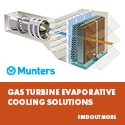Technology Overview
ECONOMICS
The economics of TIC is discussed using the examples of two cogeneration plants located in Los Angeles, CA. One plant deploys an industrial/frame CT of 83.5 MW capacity and the other uses an aeroderivative CT of 42 MW capacity.When the ambient temperature in Los Angeles is 87oF dry-bulb and coincident wet-bulb temperature is 64oF the output of the uncooled 83.5 MW and 42 MW cogeneration plants drops to about 75.3 MW and 32.1 MW, respectively. Compared to the rated capacities of the two plants, the reduced outputs represent loss of capacity by about 10% and 24%, respectively.
The technical and economic impacts of using TIC for the above two types of plants are discussed for three cooling technologies: Wetted Media (Evap Cooling), Fogging and Electric Chillers. As pointed out earlier in the discussion on technologies, the results of various TIC technologies depend on the weather (dry-bulb and wet-bulb temperatures) for the plant location.
Output Enhancement
Assuming a 90% and 98% approach to the difference between the dry-bulb and wet-bulb temperatures for the wetted media (evaporative cooling) and fogging technologies, these two technologies can cool the inlet air to 66.3oF and 64.5oF respectively. Assuming that the electric chiller system is designed for cooling the inlet air to 45oF, such a system requires total cooling capacities of 2,330 RT and 1200 RT for the 83.5 MW and 42 MW CTs, respectively. Assuming a typical electric chiller power requirement of 0.65kW/RT and an additional 0.16kW/RT for chilled water, condenser water and cooling tower pumps the total parasitic power needs for the chiller capacities are 1.9 MW and 0.96 MW for the larger and the smaller CTs, respectively. Comparisons of various TIC technologies with the uncooled CT in terms of total power plant output are shown in 1 and Figures 4 and 5.

Figure 4. Effect of TIC Technology on Net Power Output of the 83.5 MW CT
The results in Figure 4 show that evaporative cooling and fogging can enhance the capacities of the larger uncooled system (75.3 MW) to 81.3 MW and 81.9 MW, respectively. Therefore, these TIC technologies can restore most of the 10% lost capacity to within 3% of the rated capacity.
The results for the aeroderivative CT, shown in Figure 5, are similar but more pronounced than those for the industrial/frame CT. The capacity of this uncooled system goes up from 34.1 MW to 39.9 MW and 40.4 MW by the evaporative cooling and fogging technologies, respectively and thus, restores most of the 24% lost capacity to within 4% of the rated capacity.

Figure 5. Effect of TIC Technology on Net Power Output of the 42 MW CT
Even though the results of using evaporative cooling and fogging are very good, these technologies are not able to achieve the full-rated capacities. In addition, the extent of cooling achieved by these technologies depends on the ambient wet-bulb temperature. If the wet-bulb temperature goes up (i.e. outside humidity increases) their effectiveness decreases. Therefore, the results of these technologies for this plant in Houston, TX will be less impressive because of typically higher ambient humidity than that in Los Angeles, CA or Las Vegas, NV.
The results in Figures 4 and 5 show that the electric chiller system yields maximum power capacity enhancement even after accounting for the large parasitic needs of the chiller system. The chiller system in this example is designed to cool the inlet air to 45oF and is able to achieve output capacities that exceed the rated capacities. Another advantage of the chiller system is that it can be designed to achieve almost constant output independent of the ambient dry- and wet-bulb temperatures. Of course, the chiller system costs more to install than the evaporative cooling and fogging systems.
Economic Benefits
The economic benefits of the three TIC technologies, discussed above, on the installed cost for the total plant capacity for the two types of CTs are shown in Figures 6 through 9. The basis for the installed costs shown in these figures are as follows:
Cogeneration CT Plant: $750,000/MW
(No Cooling)
Wetted Media (Evap Cooling): $19,000/MW CT capacity at ISO
Fogging: $19,000/MW CT capacity at ISO
Electric Chiller: $800/RT

Figure 6. Effect of TIC Technology on Total Plant Investment for the 83.5 MW CT

Figure 7. Effect of TIC Technology on Total Plant Investment for the 42 MW CT
The results in the above Figures show that the total plant capital cost, expressed as $/MW, is lower for the plants with TIC than those for the uncooled systems.
The plant owners have only two options for increasing plants output capacity: add another CT (or another generator) or install TIC for the existing CT. The economic benefits of TIC become significantly more apparent when we compare the capital costs per unit of output enhancement as shown in Figures 8 and 9.

Figure 8. Effect of TIC Technology on Incremental Cost for Capacity Enhancement for the 83.5 MW CT

Figure 9. Effect of TIC Technology on Incremental Cost for Capacity Enhancement the 42 MW CT
The results in these figures show that for the incremental capital cost for enhancing plant capacity by one MW is significantly lower for TIC technologies than installing another uncooled CT.
As pointed out earlier, the results of various TIC technologies depend on the plant location. Therefore, the economics of these technologies would be different for the plants located in Houston, TX and Las Vegas, NV from those discussed above for the Los Angeles, CA location.
Selecting Optimum Technology
As stated earlier, all of the above discussions relate to a situation when the ambient dry-bulb and wet-bulb temperatures are 87oF and 64oF, respectively. However, this information is not sufficient to decide whether TIC is economically attractive and if so which cooling technology will be economically most attractive. Such estimates require calculations using hourly weather data for 8,760 hours of the year and also require information for cost of fuel, power demand profile and market value of power produced (which may vary with the time of day).
Many power plants across the U.S. are using various TIC technologies that best suit their needs. A database of some of these installations is available in the Experience Database section.




